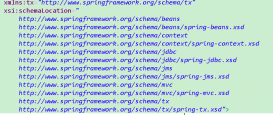前言
spring是什么?它是一个应用程序框架,为应用程序的开发提供强大的支持,例如对事务处理和持久化的支持等;它也是一个bean容器,管理bean对象的整个生命周期,维护bean的各种存在状态,例如bean对象的实例化、销毁、bean的单实例和多实例状态等。
spring作为java发展史上不可忽视的存在,说他重新定义了java也不为过。它功能强大,着实为日常开发提供了大大的便利。表面越简单的东西,背后越复杂。
从本章节开始,我们一起分析spring的源码,看它到底是怎么样来实现我们常说常用的诸如ioc、annotation、aop、事务等功能的。
1、spring的入口
在我们的项目中,web.xml必不可少,其中就定义了spring的监听器。
|
1
2
3
4
5
|
<listener> <listener-class> org.springframework.web.context.contextloaderlistener </listener-class></listener> |
我们来看contextloaderlistener类,可以看到它实现了servletcontextlistener接口,
contextinitialized就是spring初始化的入口方法。
spring还有一个入口,叫做org.springframework.web.servlet.dispatcherservlet,它们之间是父子容器的关系,最终都会调用到同一个方法org.springframework.context.support.abstractapplicationcontext.refresh()。
2、初始化
spring的初始化第一步就是要加载配置文件,然后解析里面的配置项。
ok,我们来到xmlwebapplicationcontext类的loadbeandefinitions方法。
|
1
2
3
4
5
6
7
8
|
protected void loadbeandefinitions(xmlbeandefinitionreader reader) throws ioexception { string[] configlocations = getconfiglocations(); if (configlocations != null) { for (string configlocation : configlocations) { reader.loadbeandefinitions(configlocation); } }} |
可以看到,configlocations是一个数组,它获取的就是配置文件。在笔者的项目中,只有一个配置文件,名字是applicationcontext.xml。下一步就是通过loadbeandefinitions这个方法解析这个配置文件。
3、解析xml配置
首先把一个配置文件封装成一个resource对象,然后获取resource对象的输入流,转换成inputsource对象,最后解析成document对象。下面代码只保留了主要部分。
|
1
2
3
4
5
6
7
8
9
10
11
12
13
14
15
16
17
18
19
|
public int loadbeandefinitions(string location, set<resource> actualresources) throws beandefinitionstoreexception { resourceloader resourceloader = getresourceloader(); if (resourceloader instanceof resourcepatternresolver) { // resource pattern matching available. try { //这里的location就是配置文件-applicationcontext.xml,转成resource对象 resource[] resources=resourceloader).getresources(location); //获取resources对象的输入流 再转成jdk的inputsource对象,最后解析成document inputstream inputstream = resources.getinputstream(); inputsource inputsource = new inputsource(inputstream); document doc = doloaddocument(inputsource, resource); } catch (ioexception ex) { throw new beandefinitionstoreexception( "could not resolve bean definition resource pattern [" + location + "]", ex); } } } |
applicationcontext.xml配置文件解析成document对象,它的root节点信息如下:
|
1
2
3
4
5
6
7
8
9
10
11
12
13
14
15
16
17
18
19
20
|
[ [#text:], [context:component-scan: null], [#text:], [bean: null], [#text:], [bean: null], [#text:], [bean: null], [#text:], [bean: null], [#text:], [#comment: 指定了表现层资源的前缀和后缀 viewclass:jstlview表示jsp模板页面需要使用jstl标签库 prefix 和suffix:查找视图页面的前缀和后缀,比如传进来的逻辑视图名为hello,则该该 jsp视图页面应该存放在“web-inf/jsp/hello.jsp”], [#text:], [bean: null], [#text: ]] |
4、加载bean信息
上一步我们看到spring已经把applicationcontext.xml这个配置文件解析成了document对象,接下来就是关键的一步。先看源码
|
1
2
3
4
5
6
7
8
9
10
11
12
13
14
15
16
17
18
19
20
21
22
23
24
|
//这里拿到的是document对象的根节点,根节点信息参考上图protected void parsebeandefinitions(element root, beandefinitionparserdelegate delegate) { if (delegate.isdefaultnamespace(root)) { nodelist nl = root.getchildnodes(); for (int i = 0; i < nl.getlength(); i++) { node node = nl.item(i); if (node instanceof element) { element ele = (element) node; //这里有两个分支。 //一个是处理默认的节点(import、alias、bean、beans) //一个是处理自定义的节点(context:component-scan) if (delegate.isdefaultnamespace(ele)) { parsedefaultelement(ele, delegate); } else { delegate.parsecustomelement(ele); } } } } else { delegate.parsecustomelement(root); }} |
4.1 component-scan的解析
首先定位到自定义解析方法delegate.parsecustomelement(ele);
最终调用了org.springframework.context.annotation.componentscanbeandefinitionparser.parse(element element, parsercontext parsercontext),不过它是怎么调用到这个类的呢?说起来就比较有意思了。
我们先来看spring里面的一个配置文件,/meta-inf/spring.handlers
http\://www.springframework.org/schema/context=org.springframework.context.config.contextnamespacehandler
http\://www.springframework.org/schema/jee=org.springframework.ejb.config.jeenamespacehandler
http\://www.springframework.org/schema/lang=org.springframework.scripting.config.langnamespacehandler
http\://www.springframework.org/schema/task=org.springframework.scheduling.config.tasknamespacehandler
http\://www.springframework.org/schema/cache=org.springframework.cache.config.cachenamespacehandler
这里面配置了不同标签的处理类,比如context标签处理类就是contextnamespacehandler,然后通过反射实例化这个处理类,调用它的init()方法。init()方法里面它又注册了一堆处理类,其中就有我们很感兴趣的component-scan。
|
1
2
3
4
5
6
7
8
9
10
11
12
13
14
15
16
17
18
19
20
21
22
23
24
25
26
27
28
29
30
31
|
public namespacehandler resolve(string namespaceuri) { //handlermappings里有个方法loadallproperties(),获取spring所有的配置项 map<string, object> handlermappings = gethandlermappings(); object handlerorclassname = handlermappings.get(namespaceuri); if (handlerorclassname == null) { return null; } else if (handlerorclassname instanceof namespacehandler) { return (namespacehandler) handlerorclassname; } else { string classname = (string) handlerorclassname; try { //以context:component-scan举例 //这里拿到的classname就是org.springframework.context.config.contextnamespacehandler //通过反射,实例化这个contextnamespacehandler,然后调用init方法 class<?> handlerclass = classutils.forname(classname, this.classloader); namespacehandler namespacehandler = beanutils.instantiateclass(handlerclass); namespacehandler.init(); handlermappings.put(namespaceuri, namespacehandler); return namespacehandler; } }}public void init() { registerbeandefinitionparser("annotation-config", new annotationconfigbeandefinitionparser()); registerbeandefinitionparser("component-scan", new componentscanbeandefinitionparser()); //...未完} |
最终spring就可以通过component-scan这个标签,拿到componentscanbeandefinitionparser类,调用它的parse()方法。
|
1
2
3
4
5
6
7
8
9
10
11
12
13
14
15
16
17
18
19
20
21
22
|
public beandefinition parse(element element, parsercontext parsercontext) { //获取包扫描路径,对应配置文件中的base-package="com.viewscenes.netsupervisor" string basepackage = element.getattribute(base_package_attribute); basepackage = parsercontext.getreadercontext().getenvironment(). resolveplaceholders(basepackage); //这里可能有多个包路径,分割成数组 string[] basepackages = stringutils.tokenizetostringarray(basepackage, configurableapplicationcontext.config_location_delimiters); /** * configurescanner 配置扫描器。 * scanner.doscan 扫描执行 * registercomponents 这里重点是对registercomponents的支持 * * @return */ classpathbeandefinitionscanner scanner = configurescanner(parsercontext, element); set<beandefinitionholder> beandefinitions = scanner.doscan(basepackages); registercomponents(parsercontext.getreadercontext(), beandefinitions, element); return null; } |
4.1.1 configurescanner 配置扫描器
这里面重点就是注册了默认的过滤器。use-default-filters,默认值是true,如果配置文件配置了此属性的值为false,有些注解就加不进来,到下一步扫描的时候就注册不了bean。
|
1
2
3
4
5
6
7
8
9
10
11
12
13
14
15
16
17
18
19
|
protected void registerdefaultfilters() { //这个就是配置的use-default-filters,如果配置了false。那么下面的 // component、managedbean、named注解都不会被扫描到 if (usedefaultfilters) { this.includefilters.add(new annotationtypefilter(component.class)); classloader cl = classpathscanningcandidatecomponentprovider.class.getclassloader(); try { this.includefilters.add(new annotationtypefilter( ((class<? extends annotation>) classutils.forname("javax.annotation.managedbean", cl)), false)); logger.debug("jsr-250 'javax.annotation.managedbean' found and supported for component scanning"); } catch (classnotfoundexception ex) { // jsr-250 1.1 api (as included in java ee 6) not available - simply skip. } //...未完 }} |
4.1.2 doscan扫描
doscan分为三个步骤。
- findcandidatecomponents 扫描包路径下的所有class文件,过滤有component注解的类,转换成beandefinition对象,加入一个linkedhashset中。
- 循环上一步返回的linkedhashset,设置基本属性,比如setlazyinit、setscope。
- 注册beandefinition对象,向map容器中缓存beanname和beandefinition,向list中加入beanname。
|
1
2
3
4
5
6
7
8
9
10
11
12
13
14
15
16
17
18
19
20
21
22
23
|
protected set<beandefinitionholder> doscan(string... basepackages) { set<beandefinitionholder> beandefinitions = new linkedhashset<beandefinitionholder>(); for (string basepackage : basepackages) { //findcandidatecomponents方法扫描class文件,判断component注解,转成beandefinition对象返回。 //值得注意的是,component不止是@component,还有 //@controller、@service、@repository,因为在这三个注解上面还有个@component。 //这就相当于它们都是component的子注解。 set<beandefinition> candidates = findcandidatecomponents(basepackage); for (beandefinition candidate : candidates) { scopemetadata scopemetadata = this.scopemetadataresolver. resolvescopemetadata(candidate); //设置属性,没有配置的都是默认值 candidate.setscope(scopemetadata.getscopename()); candidate.setxxx(scopemetadata.getxxxname()); string beanname = this.beannamegenerator.generatebeanname(candidate, this.registry); //registerbeandefinition方法 注册beandefinition,等同于下面两句 //this.beandefinitionmap.put(beanname, beandefinition); //this.beandefinitionnames.add(beanname); registerbeandefinition(definitionholder, this.registry); } } return beandefinitions; } |
最后整个方法返回的就是beandefinition对象的set集合,以两个controller为例。
|
1
2
3
4
5
|
[ generic bean: class [com.viewscenes.netsupervisor.controller.indexcontroller]; scope=; abstract=false; lazyinit=false; autowiremode=0; dependencycheck=0; autowirecandidate=true; primary=false; factorybeanname=null; factorymethodname=null; initmethodname=null; destroymethodname=null; defined in file [d:\apache-tomcat-7.0.78\webapps\springmvc_dubbo_producer\web-inf\classes\com\viewscenes\netsupervisor\controller\indexcontroller.class], generic bean: class [com.viewscenes.netsupervisor.controller.usercontroller]; scope=; abstract=false; lazyinit=false; autowiremode=0; dependencycheck=0; autowirecandidate=true; primary=false; factorybeanname=null; factorymethodname=null; initmethodname=null; destroymethodname=null; defined in file [d:\apache-tomcat-7.0.78\webapps\springmvc_dubbo_producer\web-inf\classes\com\viewscenes\netsupervisor\controller\usercontroller.class]] |
4.1.3 对annotation-config的支持
我们知道,在spring配置文件有个配置是context:annotation-config 但如果配置了context:component-scan 就不必再配置config,这是因为在解析component-scan的时候已经默认添加了annotation-config的支持,除非你手动设置了annotation-config="false",不过这可不太妙,因为在ioc的时候就没办法支持@autowired等注解了。
|
1
2
3
4
5
6
7
8
9
10
11
12
13
14
15
16
17
18
19
20
21
22
23
|
protected void registercomponents(xmlreadercontext readercontext, set<beandefinitionholder> beandefinitions, element element) { boolean annotationconfig = true; if (element.hasattribute(annotation_config_attribute)) { annotationconfig = boolean.valueof(element.getattribute(annotation_config_attribute)); } if (annotationconfig) { //判断annotation-config属性的值 set<beandefinitionholder> beandefs = new linkedhashset<beandefinitionholder>(4); if (!registry.containsbeandefinition(autowired_annotation_processor_bean_name)) { rootbeandefinition def = new rootbeandefinition(autowiredannotationbeanpostprocessor.class); beandefs.add(registerpostprocessor(registry, def, autowired_annotation_processor_bean_name)); } if (!registry.containsbeandefinition(required_annotation_processor_bean_name)) { rootbeandefinition def = new rootbeandefinition(requiredannotationbeanpostprocessor.class); beandefs.add(registerpostprocessor(registry, def, required_annotation_processor_bean_name)); } if (jsr250present && !registry.containsbeandefinition(common_annotation_processor_bean_name)) { rootbeandefinition def = new rootbeandefinition(commonannotationbeanpostprocessor.class); beandefs.add(registerpostprocessor(registry, def, common_annotation_processor_bean_name)); } ......未完 }} |
4.2 bean标签的解析
bean标签的解析,就是默认的处理方法。
获取bean标签的id,并且把beanname赋值为id,设置别名。新建abstractbeandefinition对象,通过反射设置beanclass,解析property属性名称和值。
|
1
2
3
4
5
6
7
8
9
10
11
12
13
14
15
16
17
18
19
20
21
22
23
24
|
public beandefinitionholder parsebeandefinitionelement(element ele, beandefinition containingbean) { //获取bean_id string id = ele.getattribute(id_attribute); string beanname = id; abstractbeandefinition beandefinition = parsebeandefinitionelement(ele, beanname, containingbean); string[] aliasesarray = stringutils.tostringarray(aliases); //最后返回已经包含了beanname、class对象和一系列方法的beandefinition对象 return new beandefinitionholder(beandefinition, beanname, aliasesarray);}public abstractbeandefinition parsebeandefinitionelement(element ele, string beanname, beandefinition containingbean) { string classname = ele.getattribute(class_attribute).trim(); try { //根据classname反射设置setbeanclass和setbeanclassname abstractbeandefinition bd = createbeandefinition(classname, parent); //设置默认方法 setscope、setlazyinit、setautowiremode... parsebeandefinitionattributes(ele, beanname, containingbean, bd); //设置property属性 <bean><property name="id" value="1001"></property></bean> parsepropertyelements(ele, bd); return bd; } return null;} |
注册beandefinition对象,和component-scan扫描的bean注册一样。向容器中填充对象。
不管是xml配置的bean,还是通过component-scan扫描注册的bean它们最后都是殊途同归的,会转换成一个beandefinition对象。记录着这个bean对象的属性和方法,最后都注册到容器中,等待在实例化和ioc的时候遍历它们。
以上就是本文的全部内容,希望对大家的学习有所帮助,也希望大家多多支持服务器之家。
原文链接:https://www.jianshu.com/p/baa1d48e7f57













